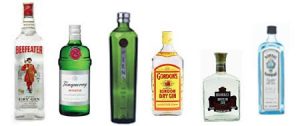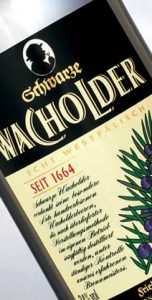Gin
Product of the distillation of grain flavored with juniper berries, coriander, licorice, angelica, broom and other plants. The tradition tells that Sylvius Franciscus, Dutch chemist, doctor and professor of the University of Leiden in the seventeenth century experienced a remedy to cure stomach and kidney ailments based on the administration of grain alcohol and juniper berries: it was born Jenever which then evolves into "Gin". This elixir immediately achieved success in Holland and soon arrived in England. The British did not stop at simply import but contributed to the development of this spirit, to turn it into an alcoholic beverage to be tasted at any time rather than only as a medicine. They put the berries directly in infusion, unlike the original recipe which provided using of berry oil, with coriander, orange peel and other plants to round the scent and taste: thus was born the "London dry Gin". His popularity had continuous growth that did not stop even during the period of Prohibition, set out with the promulgation of "Gin Act", a law that imposed a high tax on the drink trying to reduce consumption and production. This measure, of course, did not bring the desired results that monarchy expected but encouraged the illegal production and import from France and Netherlands, especially from the city of Schiedam, the name with which the British still identify the Dutch Gin. To face new problems, provoked by the prohibition, George II in 1742 decided to repeal the Gin Act and to begin a policy of fiscal control in order to promote competition between producers and consequently increase the level of quality. In early 1900 there was recorded a phenomenon that definitely revolutionized the concept of drinking: born the "Gin Palace". The grimy taverns were replaced by elegant and nicely furnished locals, frequented by the new social class, the bourgeoisie, that rose to prominence thanks to industrialization becoming one of the symbols of the Victorian era. It was born the habit of drinking Gin mixed with water, soda and lemon, which among the English settlers soon began, with the addition of cinchona, the famous tonic cocktail - Gin Tonic! The European directives recognize two methods of production of Gin: one made with distillation, which is used in Netherlands, and the other one with spirit aromatization, which is used in England. The first involves distillation with use of pot stills of cereal alcohol mixed with juniper berries and other aromatic plants. The result is a spirit with a robust body and very aromatic. After the second distillation it is obtained "double Gin". The second one starts from a base of neutral ethyl alcohol - 96% alcohol by volume - of whichever origin, that is flavored through the technique of maceration or percolation with juniper berries, coriander, licorice root, angelica, orris, cardamom, anise and fennel seeds, lemon and orange peel, cumin and almonds. After distillation the obtained result with continuous still, which gives that distinctive dry taste, it is created the "London dry Gin". There are several varieties of Gin: London Dry Gin, colorless, dry, aromatic, where you can find the words "premium" indicating a higher percentage of alcohol by volume; Old Tom Gin, made in England, colorless and slightly sweetened; Plymouth Gin, colorless, dry, with intense aroma with characteristic hints of roots, must be produced in the area of Plymouth, England. Golden Gin, aged in oak barrels which give it a light golden color; Jenever Gin, produced in Holland and perfected in characteristics earthenware bottles; Sloe Gin, with its characteristic purple color, slightly sweetened and flavored with wild plums; Pink Gin, flavored with Angostura; Orange and Lemon Gin, colorless and flavored with citrus essences.



